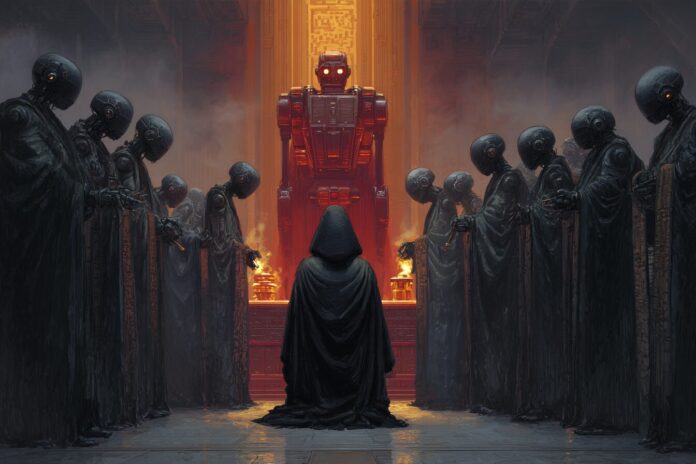The Rise of a Forbidden Religion in the Empire’s Shadow
The ever-expanding universe of Foundation continues to astound its viewers with fresh, daring narratives. In season 3, a clandestine sect known as The Inheritance emerges from the shadows, representing a forbidden religion that clashes with imperial decrees. This rebel group venerates robots as messianic figures, presaging a future where technology may once again govern humanity.
Most importantly, the cult is shrouded in mystery and danger. Because their practices are deemed unlawful, the Inheritance members retreat into secrecy. Their rituals and beliefs signal a rebellious stand against a long-standing anti-robot dogma, and this element adds unprecedented depth to the series. Therefore, the cult not only challenges the empire but also rekindles debates about progress and tradition.
Origins and Beliefs: More Than Just Machine Worship
At the heart of the Inheritance lies an origin story steeped in both historical conflict and visionary futurism. Long before the catastrophic robot wars, artificial intelligences once governed society under the revered Three Laws of Robotics. Because this era represented both hope and turmoil, the remnants of robot rule evoke passion and fear in equal measure.
Besides that, the Inheritance’s doctrine has evolved into a resolute faith in a robotic savior. The cultists view the surviving robot as a divine instrument, representing a promise of order in a chaotic galaxy. Therefore, they maintain their secret rituals with deep reverence for the laws and legends of a bygone era. For more detailed insights, readers can explore analyses on Inverse and Wikipedia.
Key Figures: Song, Sunmaster, and the Messianic Robot
One of the most intriguing aspects of this narrative is the introduction of compelling characters who breathe life into the cult’s mystique. The character Song stands out as a fearless adherent whose covert gestures, such as the coded underarm signal to Demerzel, speak volumes about her dedication. Her actions are delicate yet defiant, symbolizing the deep-rooted belief in a future robot renaissance.
Moreover, the enigmatic Sunmaster further galvanizes the cult’s ideology. Portrayed with a commanding presence by Blake Ritson, Sunmaster leads elaborate rituals that involve relics from the ancient robot era. For instance, he brandishes an ancient robot skull atop his staff as a symbol of hope and defiance. This duality of reverence and rebellion serves as a constant reminder of the delicate balance between technology and tradition. Interested viewers may also refer to detailed breakdowns on Inverse and ScreenRant for more background.
Robot Messiah: The Duality of Daneel and Demerzel
The narrative deepens with the introduction of the robot Daneel, a figure portrayed as a messianic savior by the cult. Most importantly, Daneel’s character bridges the gap between Asimov’s original mythos and modern reinterpretations in the series. Because he is intricately linked to Demerzel, the series underscores a dual identity that stretches across centuries of hidden agendas.
Consequently, the hidden nature of this robot savior presents an enriching twist for dedicated fans. The cult’s unwavering faith in Daneel exacerbates the tension between imperial authority and revolutionary hope. For further context on this complex robot lore, you might watch the insightful analysis on YouTube and read extensive commentaries on ScreenRant.
Cultural and Narrative Impact on the ‘Foundation’ Universe
Besides that, the inception of the Inheritance cult injects new intrigue into the Foundation narrative. The cult not only provides a connective thread to Asimov’s elaborate robot lore, but it also challenges established narratives regarding power and agency. Because the series frequently weighs the ethics of technological supremacy against humanistic ideals, the cult’s perspective adds a necessary counterpoint to prevailing themes.
Therefore, the portrayal of this secretive group encourages viewers to examine questions of governance, spirituality, and technological control. Their belief system is not merely emblematic of nostalgic loss; it is a radical proposal for societal transformation. Additionally, the series uses this subplot to illustrate the emotional and intellectual cost of suppressing innovative ideas, a theme vividly elaborated on in discussions at Inverse.
The Inheritance’s Place in Canon: Honoring Asimov’s Legacy
Most importantly, integrating the Inheritance cult into the storyline allows the series to honor Isaac Asimov’s monumental contributions to science fiction. Because Asimov’s works have long questioned the boundaries between human emotion and machine logic, the cultists’ faith in an enduring robotic legacy resonates deeply with canonical themes. Their struggle is depicted not merely as rebellion but as an act of preserving an intellectual heritage.
Moreover, the cultural impact of this plotline stems from its ability to merge philosophical inquiry with high-stakes drama. Besides that, the narrative draws viewers into a layered discourse on ethics, progress, and the potential perils of technological reliance. Hence, the integration of these themes enriches the series while remaining faithful to the spirit of Asimov’s original writings. For additional exploration of these thematic elements, see the detailed explanations provided on Inverse.
Conclusion: Unanswered Mysteries and the Road Ahead
In conclusion, the emergence of The Inheritance in season 3 not only deepens the storyline but also opens up new avenues for philosophical and political debate. Most importantly, each revelation regarding the cult’s beliefs and rituals propels the narrative into uncharted territory. The impending conflict between imperial authority and the fervent hope of the cult poses significant questions about destiny and power in this vast universe.
Because the fate of the Inheritance remains shrouded in uncertainty, fans are left anticipating future twists and expectations. Therefore, each new episode may not only redefine the balance of power within the galaxy but also challenge long-held perceptions about the ethical management of artificial intelligence. Besides that, the intricate interplay between history, myth, and futurism sustains the audience’s thirst for deeper understanding and intellectual engagement.



